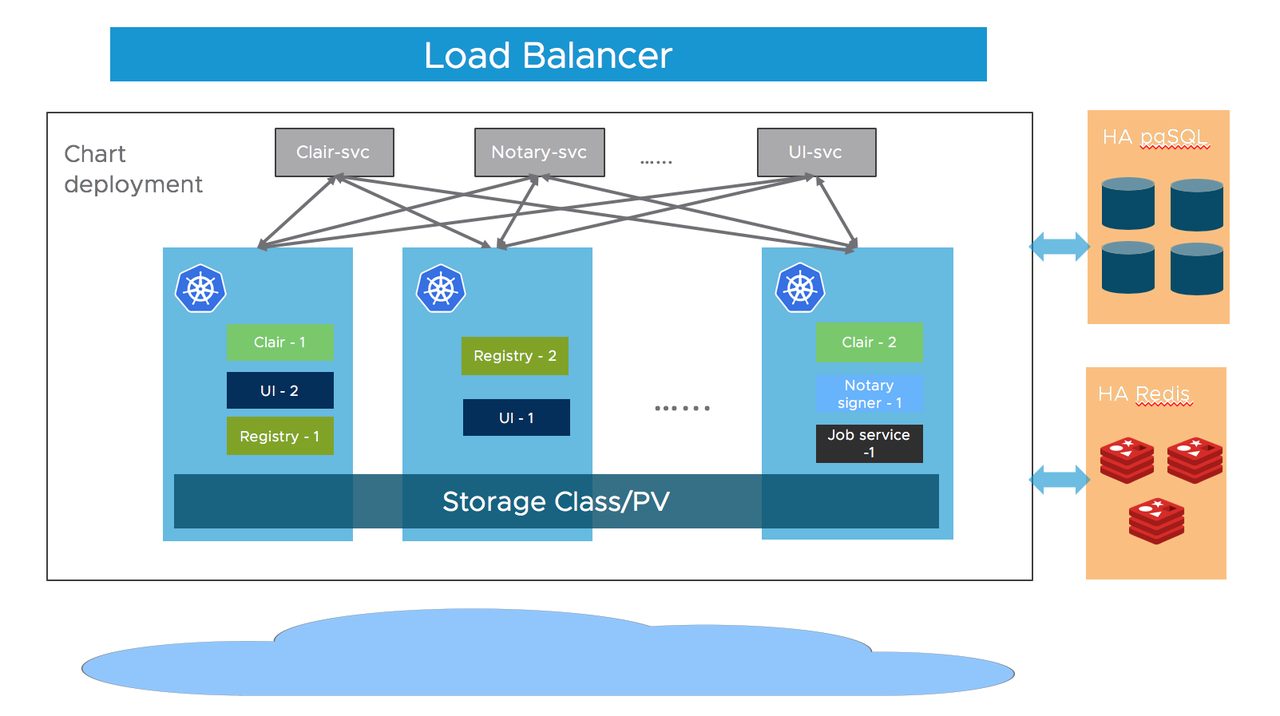说到搭建自建 Docker 镜像仓库,业内推荐最多的是 Harbor。然而,Harbor 并没有集成高可用(HA),这使得其服务相对不那么可靠。如果开发者想要创建一个高可用 Harbor 集群,通常需要先创建和配置高可用 Redis 和 PostgreSQL 集群,但这一过程却相当麻烦。

图 1. Harbor 架构图
现在有了 KubeBlocks ,您只需简单几步即可搭建高可用 Harbor 集群。
为什么选用 KubeBlocks
KubeBlocks 是开源管理控制平面,支持在 K8s 上运行和管理数据库、消息队列和其他数据基础设施。KubeBlocks 支持管理多种数据引擎,包括 RDBMSs(如 MySQL、PostgreSQL)、内存型(Redis)、NoSQLs(MongoDB)、MQs(Kafka、Pulsar)等等。
本文将演示如何使用 KubeBlocks 在 5 分钟内搭建一个高可用 Harbor 集群。
环境准备
开始之前,请确保您的环境满足 KubeBlocks 和 Harbor 的环境要求。
安装 kbcli 和 KubeBlocks
- 安装 kbcli。
- 安装 KubeBlocks。
- 检查 KubeBlocks 是否安装成功。
- 在 KubeBlocks 中开启 PostgreSQL 和 Redis 引擎。这两个引擎默认开启。您可以执行以下命令,检查引擎启用状态。如果引擎未启用,您可以参考
创建 PostgreSQL 和 Redis 集群
- 创建一个名为 demo 的独立 namespace,将集群资源独立出来。
- 创建 PostgreSQL 集群。本文中我们使用了 replication 模式,创建了主备集群,可支持自动故障转移。关于创建集群的细节,可参考
- 创建 Redis 集群。本文中我们使用了 replication 模式,指定版本为 redis-7.0.6。KubeBlocks 将创建 sentinel 模式的主备集群,关于创建集群的细节,可参考
- 查看已创建的集群状态,确保两个集群的状态都为
连接集群
KubeBlocks 官方文档根据不同的情景,提供了多种连接集群的方式。您可根据实际场景选择对应的方式。本文中我们将使用试用环境的方式来演示连接至集群。
连接到 PostgreSQL 集群
- 连接至 PostgreSQL 集群。
- 在 PostgreSQL CLI 客户端中,创建新用户。
- 为 Harbor 创建新的数据库注册表。
此处创建的用户和数据库将在安装 Harbor 时使用。
连接到 Redis 集群
- 连接至 Redis 集群。
- 创建用户。
安装 Harbor
- 下载 Harbor Helm chart。
- 获取集群中服务信息。
3.在 values.yaml 文件中配置 PostgreSQL 数据库。使用 KubeBlocks 提供的外部数据库,并填写必要的数据库信息。如需配置其他参数(如 expose.type),可参考 官方文档。
4.在 values.yaml 文件中配置 Redis 数据库。
- 安装 Harbor。
- 检查 Pod 状态,确保所有服务都处于 Running 状态。
至此,部署完成,您可以照常连接 Harbor UI。
高可用演示
本节将演示 KubeBlocks 创建的 Harbor 集群的高可用能力。我们将通过 PostgreSQL 集群主节点故障来模拟。
- 查看 PostgreSQL 集群和 Pod 的初始状态。当前,
mypg-postgresql-0为主节点,mypg-postgresql-1为备节点。
2.向 Harbor 注册表中推送一个名为 busybox 的测试镜像。
3.查看 Harbor 仓库,可以看到该镜像已成功推送到 Harbor 注册表。
- 接下来,模拟 PostgreSQL 主节点故障。
5.查看集群日志,观察故障发生时节点角色变化。
从日志中我们可以看到,leader lock 从主节点释放出来,触发了 HA 切换,并从备份数据中创建出新的副本。该服务几十秒便恢复正常。
原来的备节点 mypg-postgresql-1 获得了 leader locks,成为主节点。
6.再次查看 PostgreSQL 集群和 Pod 的状态。故障切换后,mypg-posgresql-0 变成了备节点,mypg-postgresql-1 变成了主节点。
7.连接到 PostgreSQL 集群,查看主节点的 replication 信息。

结果显示 mypg-postgresql-0 已被分配备节点角色。
8.验证 Harbor 集群的服务。这里我们拉取之前推送的 busybox 镜像。该镜像可以成功地从 Harbor 注册表中拉取。同时,我们也推送了新镜像 hello-world。该镜像也能够成功推送到 Harbor 注册表。故障切换后,Harbor 集群的读写功能已恢复,证实了 KubeBlocks 提供的高可用功能的有效性。
集群扩容
KubeBlocks 提供了垂直和水平扩容的能力。您可以通过执行以下命令轻松扩容集群。
- 垂直扩容
- 水平扩容
总结
通过集成 KubeBlocks,仅需 5 分钟,您就可以拉起高可用 Harbor 集群,并能确保您的 Harbor 集群能提供持续、可信赖的服务。KubeBlocks 简化了整个创建过程,因此您可以有更多的精力去关注重要任务,而无需担心底层基础设施的配置和管理。





















 496
496

 被折叠的 条评论
为什么被折叠?
被折叠的 条评论
为什么被折叠?








